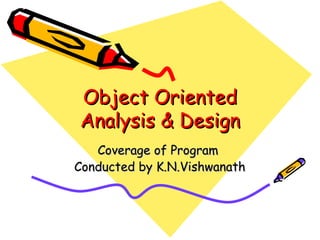
OOAD Coverage of Program
- 1. Object Oriented Analysis & Design Coverage of Program Conducted by K.N.Vishwanath
- 2. Key Features of the Program • Duration – 4 Days • Modeling based on Unified Modeling Language (UML) • Based on IBM Rational Unified Process • Sparx Systems Enterprise Architect will be used as a tool for modeling • Case study driven • Pre-test and Post-test (on request) • *Free Post program doubt clearing session (1/2 day) after a gap of at least 1 month • Course Material and design model developed during training in **softcopy form. *Only in Bangalore & Mysore. *Outside Bangalore, on request at actual. **Save Environment & Reduce Cost
- 3. Pre-Requisites • Prior knowledge of any one OO language • An open mind to look beyond programming • Continuous attendance • Minimum 10 participants for effective discussions
- 5. Object Orientation Concepts • Classes and Objects • Concepts of OO like Abstraction, Encapsulation, Modularity, Hierarchy • Packages, Components, Subsystems & Interfaces • Relationships – Association – Dependency – Realization – Generalization
- 6. Use Case Modeling • Actors • Use Cases • Use Case modelling guidelines • Use case specification • Supplementary specification • Glossary
- 7. Domain Analysis / Architectural Analysis • Identify the abstractions • Identify relevant analysis mechanisms • Model key abstractions in a class diagram • Prioritize and Plan use case realizations
- 8. Robustness Analysis / Use Case Analysis • Review the use case specifications • Identify analysis classes • Develop interaction diagrams based on use case specification • Develop class diagram based on interaction diagrams • Identify responsibilities and attributes of analysis classes
- 9. Identify Design Elements • Identify design elements based on analysis classes • Identify applicable design patterns • Package the design elements • Allocate the design elements to the architectural layers
- 10. Describe Design Mechanisms • Identify the design and implementation mechanisms • Describe the behaviour associated with the design mechanism through interaction diagrams • Develop class diagrams as patterns • Package design mechanisms for reuse
- 11. Describe Run Time Architecture • Identify processes and threads • Map design elements to the processes • Identify relationships between processes
- 12. Describe Distribution • Identify network configuration • Map processes to nodes
- 13. Use Case Design • Refine the use case realizations – Incorporate design elements – Incorporate design mechanisms – Incorporate design patterns • Document the refinements in interaction and class diagrams
- 14. Class Design • Specify operations • Specify methods • Understand state behaviour • Specify attributes • Refine Relationships • Re-factor Design (if necessary)
- 15. Database Design • Map packages to schema • Map design classes to the tables • Map class attributes to columns • Map relationships to PK / FK relationships • Map class operations to procedures and triggers